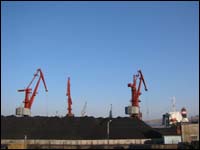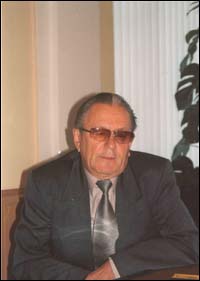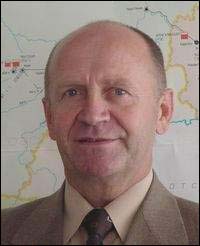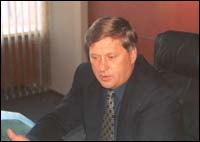 GAS &
COAL GAS &
COAL |

Primorsky Krai's economic growth is largely dependent
on the provision of cheaper energy, as the region
is currently held back by outdated coal power
stations and on its reliance on coal transported
from other regions in order to generate a percentage
of its energy. This has resulted in energy tariffs
that are higher than in Western parts of Russia,
this is particularly problematic for businesses,
which pay higher rates than private consumers.
The public heating and electricity systems have
also been dogged by winter blackouts in recent
years which made international headlines, painting
the region in a less then positive light, due
to local authorities failing to stock up on winter
fuel and price rises. Conditions however are improving
and investment is a key issue regarding improving
local energy management and electricity supplies,
" The stability of our energy supply must
be the platform where we should start to invest
money." Says Mr.
Victor Myasnik, General Director of FEMEC
(The Far Eastern Energy Management Company.)
 COAL RESOURCES COAL RESOURCES |

While the region has extensive coal reserves,
unfortunately the mining industry fell on hard
times after the breakup of the former Soviet Union
causing many operational mines to close. Local
mines managed to produce only 10.5 million tons
last year, while an average of 15 million tons
are needed annually for generating sustainable
power and heating supplies.
However the largest regional coal extracting company,
Primorskugol, recently
came under the control of the Siberian Coal Energy
Company, which is owned by Moscow's MDM Group.
The company owns shares in coal producing companies
in Siberia and Sakhalin and large-scale investment
could enable the region to harness its own energy
resources. The move is encouraging as the Siberian
Coal Energy Company is one of the third largest
coal corporations of Russia that at present extracts
more then 12% of energy coals and greatly influences
the economic situation of Siberia and the Russian
Far East.
"The Krai has more than 2 billion tons of
coal," says Mr.
Anatoly Vasyanovich, general director of Primorskugol.
"That means we have supplies for many hundreds
of years."

Yet Vasyanovich admits that the industry urgently
requires investment to update equipment. "We
are trying to work with help from our Russian
businessmen. At the moment we are working with
Japan and South Korea. We are also trying to attract
the interest our nearest neighbor - North Korea
as they have sent delegations to our company,"
says the general director.
 REGIONAL
ENERGY REGIONAL
ENERGY |
Regional and national politicians have neglected
the problem of energy production in the Russian
Far East, believes Vasyanovich: "I think it
is a significant shortcoming of the Ministry of
Energy and the Primrosky Krai Administration that
they have not paid enough attention to providing
the Krai with solid fuel."

First
vice-governor Alexander Kostenko agrees that
living in Primorsky Krai is "very expensive,"
due to high-energy tariffs, which drive up the cost
of production and everyday living. "The administration
must create a good business environment here for
industrial and power sector development," states
Kostenko.
Cheaper energy is the key to preventing population
decline and for attracting factories and local production
from the regions available raw materials. The region
needs to focus on this sector particularly in light
of the diminishing fishing sector, once the region's
major industry, which is now debatable due to an
ageing Soviet fleet, quota wrangles and over fishing
in international waters.

|
"The problem of
Primorsky Krai is that we do not have a large enough
quantity of local coal and the energy sector still
depends upon delivered coal," says Yuri
Likhoida, vice governor for oil and gas at the
regional administration, stating that the region
imports 3 million tons of coal per year from other
regions. However, he predicts energy self-sufficiency
within two years, thanks to the development of open
cast mine projects in the region.
Primorsky Krai at present has no gas power stations,
but Mr. Likhoida sees
the priority as updating existing coal power stations
rather than gasification: "There are 12 cities
on the territory of Primorsky region and we want
to gasify only 3 of them. The cheapest fuel is
still coal, so we plan on developing coal reserves
for another 20 years to come," he says.

Local energy supplier Dalenergo and the region's
largest electricity generator LuTEK are owned
by the state energy grid UES (United Energy Systems)
and managed locally by FEMEC
(Far Eastern Managing Energy Company) but
Mr. Likhoyda believes
they could become more efficient under private
ownership.
"In my view, the prospect that "Dalenergo"
or "LuTEK" might become private is only
encouraging," says Likhoida.
"The new structure of UES is currently being
reviewed, and in the program it is provided that
electric power stations, trade and all services
that includes repairing and reparations will be
private."

Energy management within the region is also being
modernized in order to maximize production. FEMEC
controls the finances of LuTEK and Dalenergo,
and hopes to attract private investment to the
sector, which is of key importance for future
economic stability and development.
Mr.Viktor
Myasnik, General Director of FEMEC,
says that, "We are ready to give an opportunity
to investors who will work with us to help heat
and manage our cities. We are even ready to sell
our enterprises for private ownership provided
the right investor comes along. We must do this
as the future of energy resources in the region
lies in competition, and not in monopolization."
He continues to express his desires for future
competition in the energy sector that will continue
to drive energy tariffs lower and improve their
potential for investment. "We have to create
the competitive ability for our output as for
the sale of energy and heat. Ultimately our investment
attractiveness has to lead to this." says
Myasnik.
 FUTURE
ENERGY PROJECTS FUTURE
ENERGY PROJECTS |
Furthermore the oil and gas projects on nearby Sakhalin
could transform the region's energy situation, and
chief among the projects to benefit from it is the
planned Primorye Oil and Gas
Complex. The project was presented at last years
APEC Investment Mart, in the name of the Primorye
Administration

The project that has an estimated cost of $160 million,
of which $152 would come from foreign companies,
is unique to the region. The
Primorye Oil and Gas Complex managed by Mr.
Valery D.Tsymbal plans to cash in on the Sakhalin
boom by building an oil refinery, gas terminal and
500 Megawatt gas and steam power station at the
site in Fokina, situated approximately 2 hours away
from Vladivostok.
The terminal would pipe liquefied natural gas to
coal power stations in Nakhodka, Artyom and Vladivostok,
enabling them to convert to cheaper and more efficient
gas, while the oil refinery would generate 4 million
tons of oil per year.
The gas terminal needs to be ready by 2006, when
a plant to liquefy natural gas will also be completed
on Sakhalin. The project is included in the Federal
Programme to develop the Far East and the Trans-Baikal
area and the Programme for the Development of Primorye
Fuel and Energy Complex 2000-2015.
The oil and gas project would cost $650 million,
of which $618 million would come from the foreign
investor, according to the company's APEC proposal.
A nuclear power station will also be built in the
region, confirms Likhoida,
saying that the region will be able to sell energy
to neighboring countries that lack energy generating
capacity, such as Japan and the Republic of Korea.
Another project that could alleviate Primorsky Krai's
energy shortages is a $5 billion 2,500-mile oil
pipeline running from Siberia to the Sea of Japan,
with a possible outlet proposed at Nakhodka or in
Khasansky region. This project, however is still
at initial talking stages, and is in competition
with another proposal for a pipeline construction
from Siberia to northeast China, which would be
shorter and cheaper variant. Talks regarding the
Chinese option are currently at a more advanced
stage.
Optimistic about Primorsky Krai's energy future,
governor Darkin talks of
plans to build an aluminium plant in the region,
currently at the stage of feasibility study. "The
Primorsky region was lacking power, and there was
a crisis in the regional power sector. Yet now we
are discussing the construction of a plant with
an objective to export power through aluminium.
It is a huge gap and an example of what has happened
in Primorye over the last two years,"
says the governor proudly. The regional administration
is spending a quarter of the regional budget on
new economic projects, which translated to approximately
$150 or $200 Million in 2002. "For over 10
years this is the first time that we're doing this,"
says Darkin.
|

